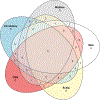Patterns of congenital anomalies among individuals with trisomy 13 in Texas
- PMID: 33749998
- PMCID: PMC8193718
- DOI: 10.1002/ajmg.a.62175
Patterns of congenital anomalies among individuals with trisomy 13 in Texas
Abstract
Few population-based studies have analyzed patterns of co-occurring birth defects among those with trisomy 13. We evaluated the frequency of all possible combinations of any one, two, three, or four additional co-occurring birth defects among 736 individuals with trisomy 13 using data from the Texas Birth Defects Registry for deliveries during 1999-2014. We calculated the observed-to-expected ratio for each combination, adjusting for the known tendency for birth defects to cluster non-specifically. To address potential ascertainment differences among live births and non-live births, we repeated analyses specifically among live births. The combination of defects with the largest observed-to-expected ratio was microcephalus, reduction deformities of brain (e.g., holoprosencephaly), anomalies of nose, and polydactyly. As expected, most of the highest 30 observed-to-expected ratios involved combinations with documented features of trisomy 13, including defects of the scalp (e.g., aplasia cutis) and heart. Results were similar among sensitivity analyses restricted to live births. Our findings may help further delineate the phenotypic spectrum for trisomy 13 and may inform future research related to improving screening and counseling for the condition.
© 2021 Wiley Periodicals LLC.
Conflict of interest statement
CONFLICT OF INTEREST
The authors declare no potential conflict of interest.
Figures
References
Publication types
MeSH terms
Grants and funding
LinkOut - more resources
Full Text Sources
Other Literature Sources
Medical
Research Materials


